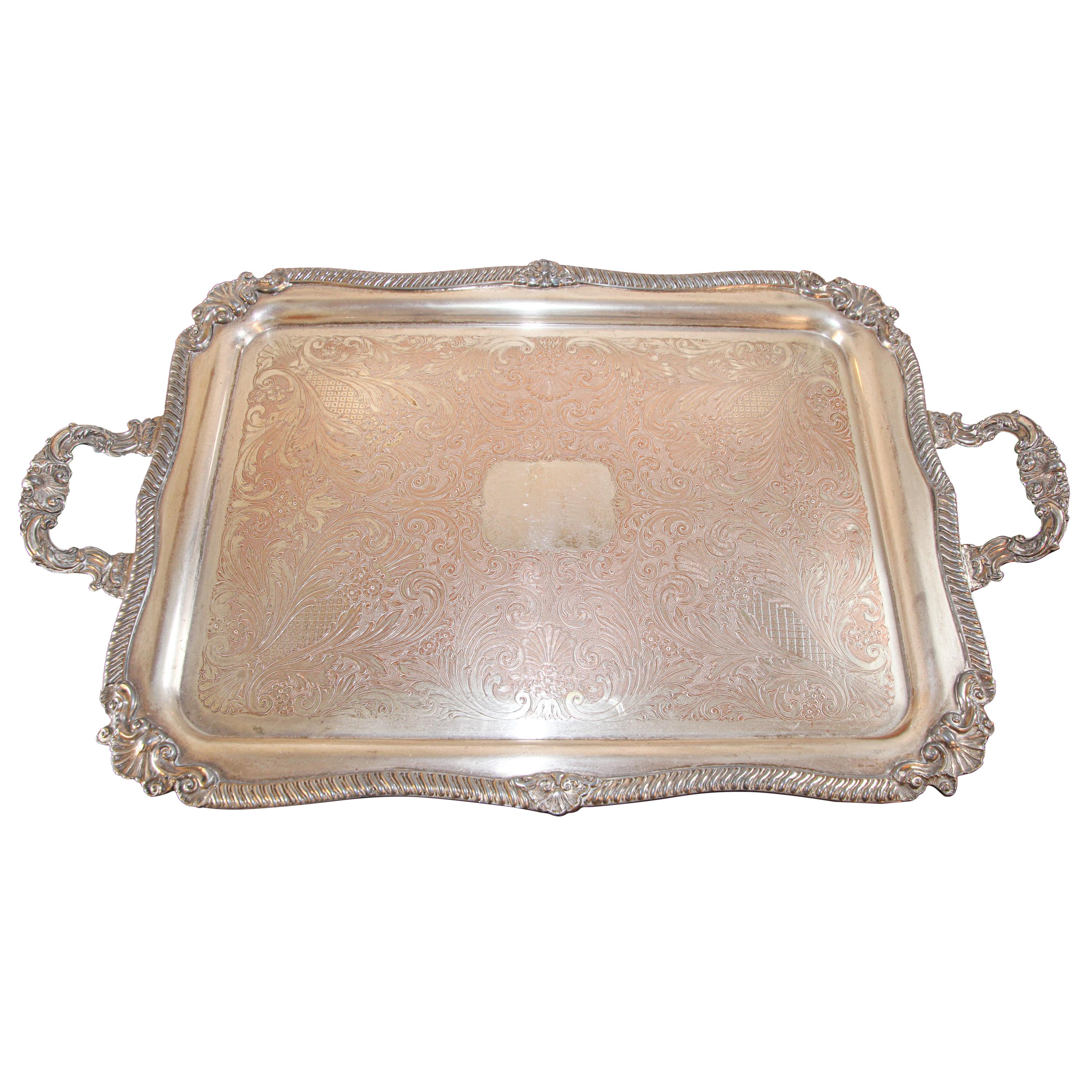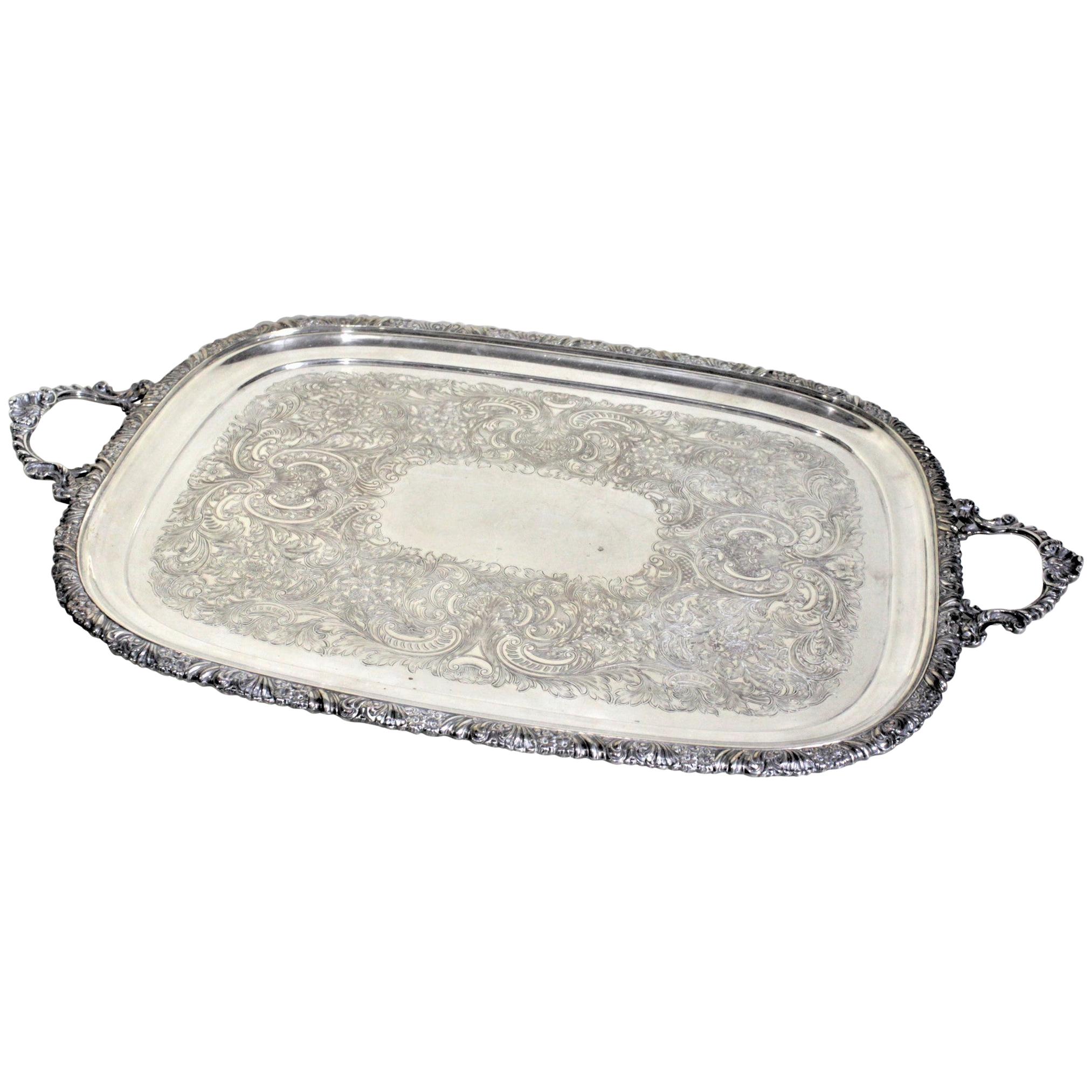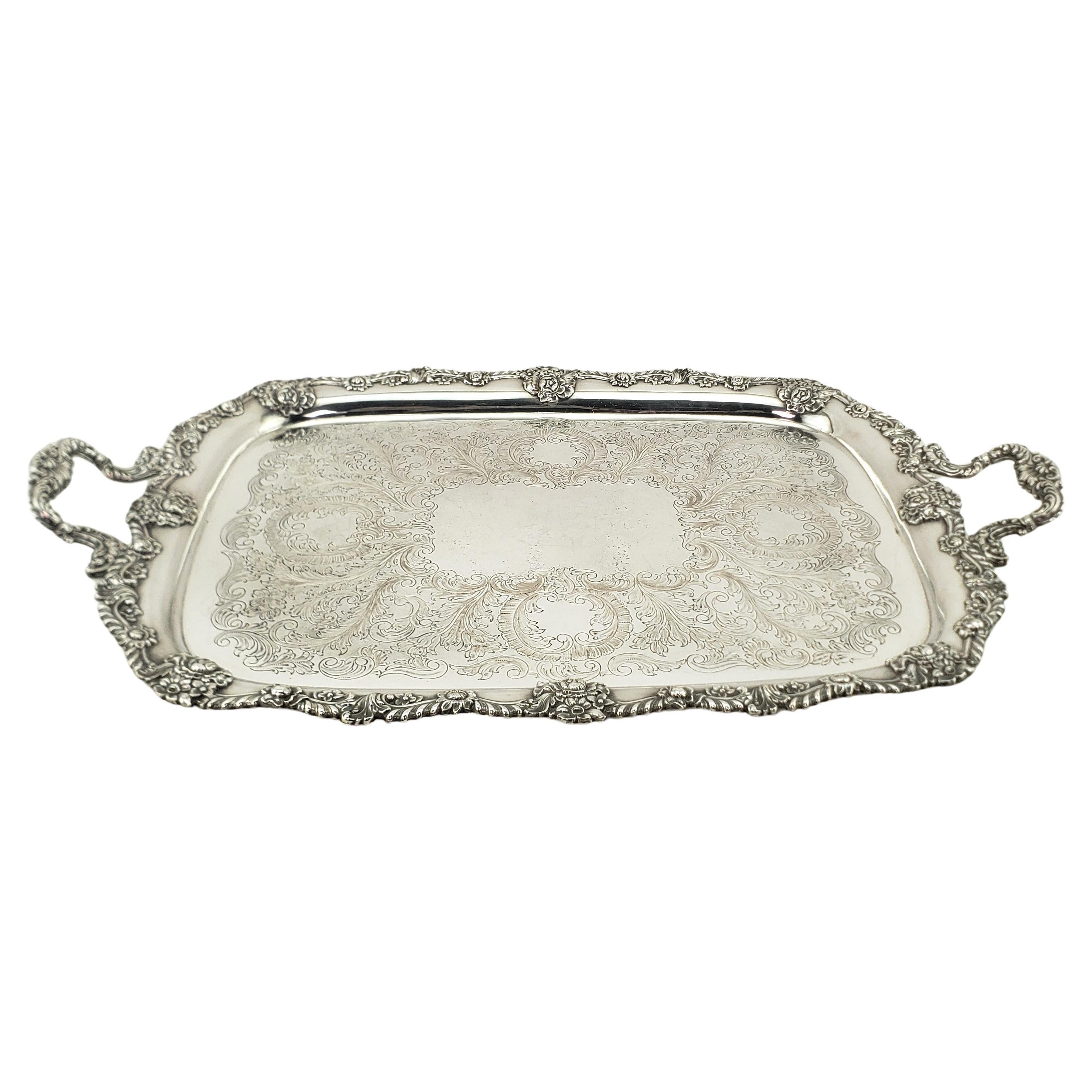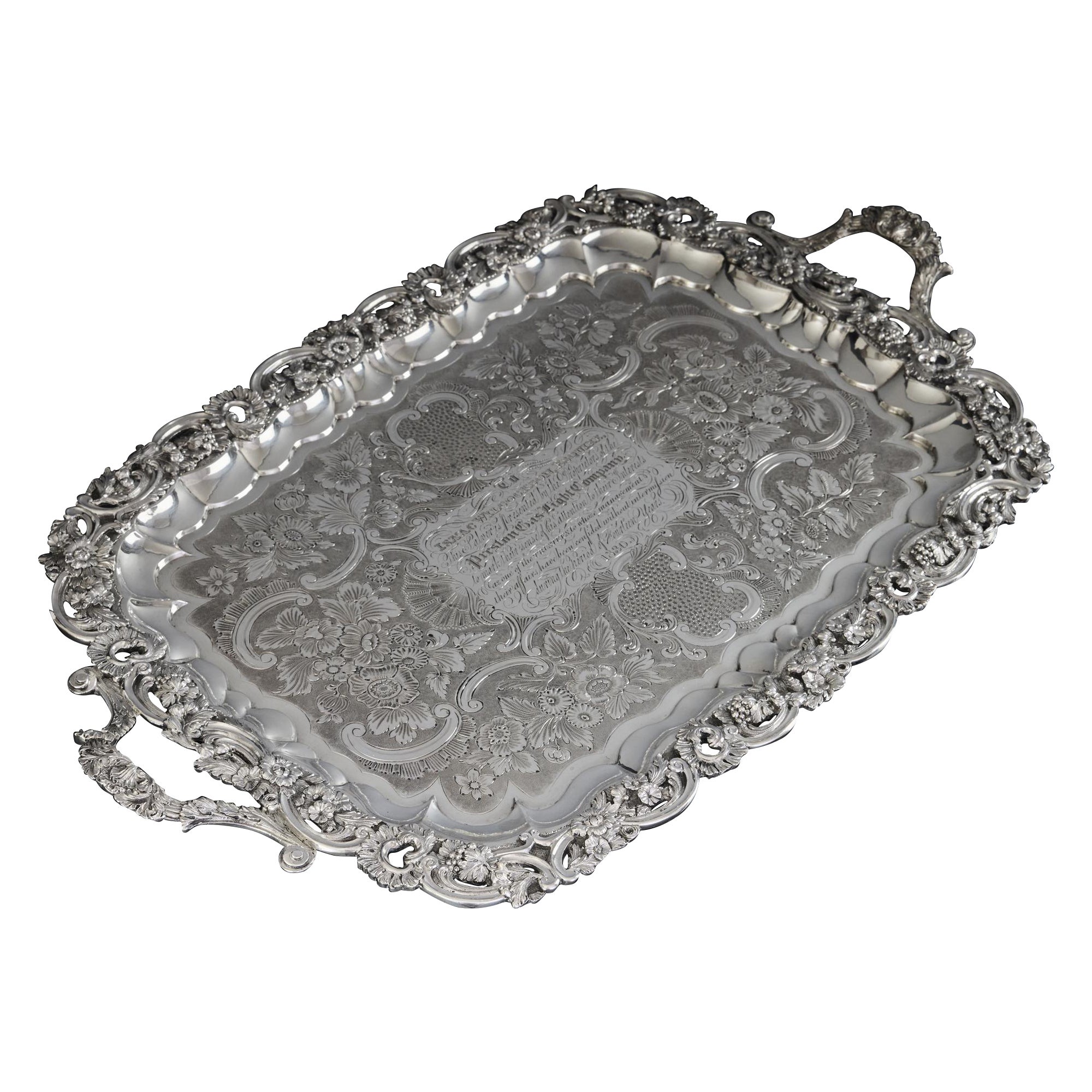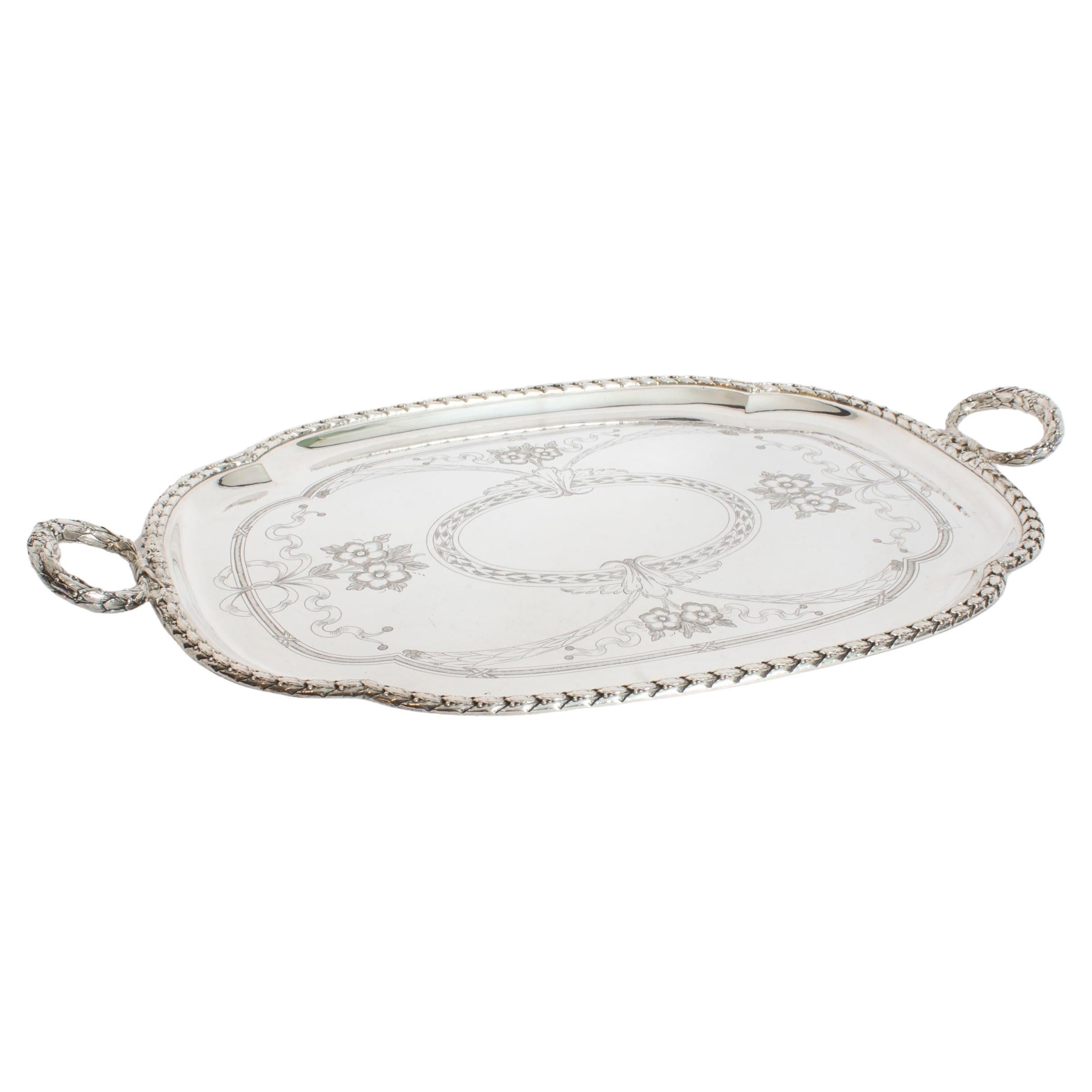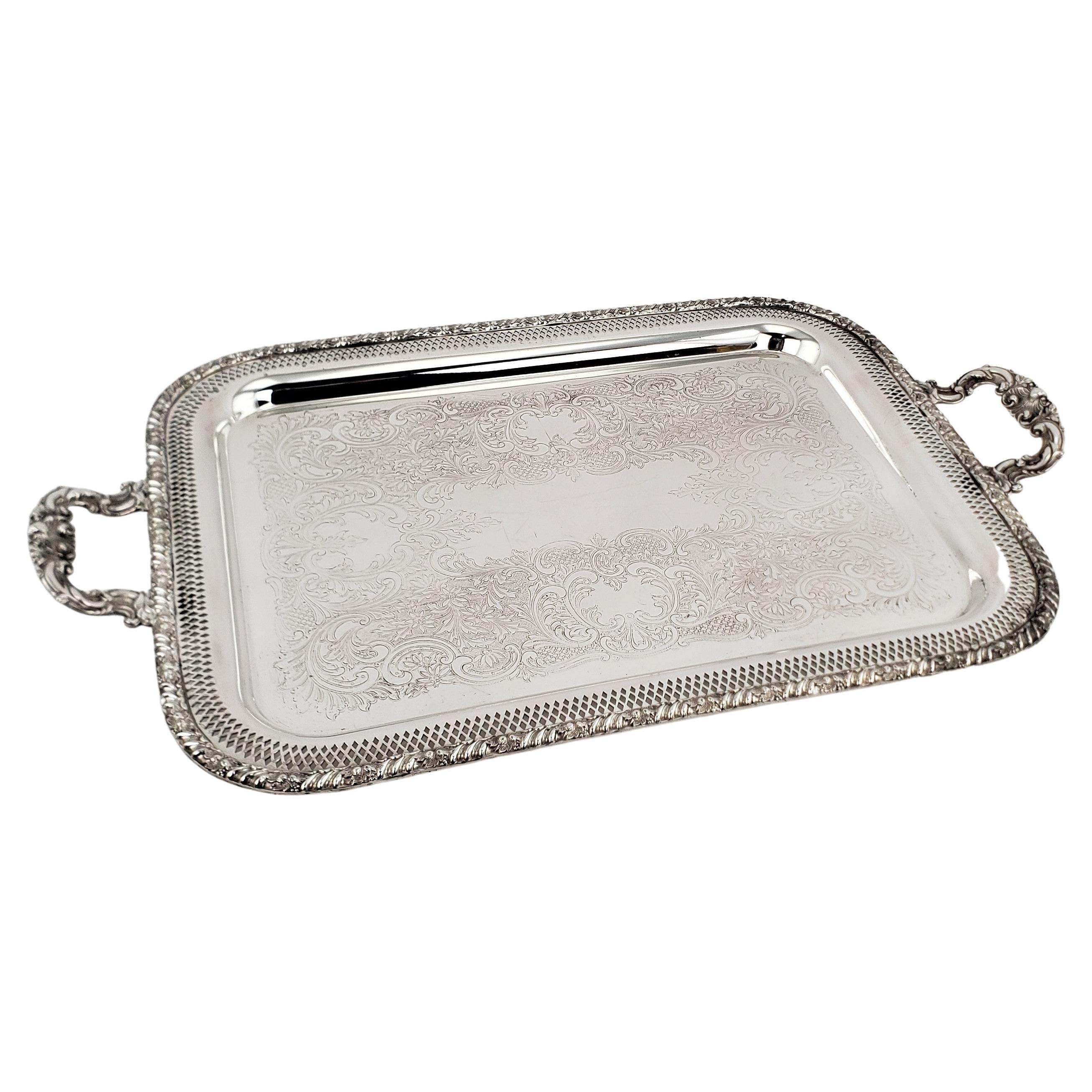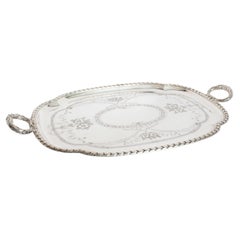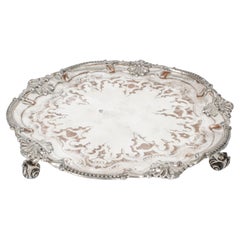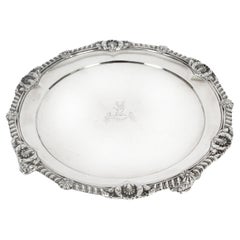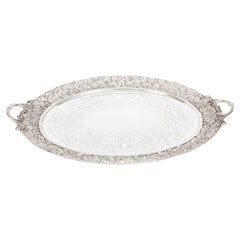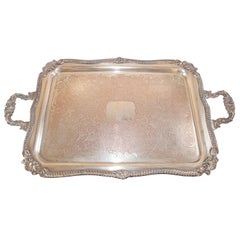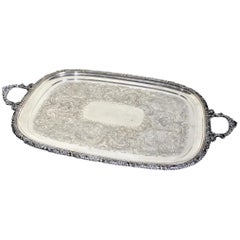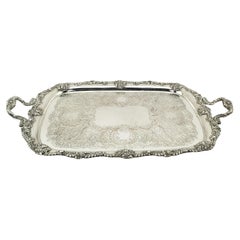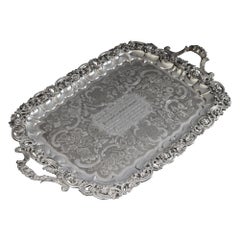Items Similar to Antique Old Sheffield Silver Plated Tray George III 1780s
Want more images or videos?
Request additional images or videos from the seller
1 of 14
Antique Old Sheffield Silver Plated Tray George III 1780s
$1,066.72
£775
€908.43
CA$1,456.28
A$1,620.05
CHF 849.25
MX$19,796.62
NOK 10,814.15
SEK 10,180.03
DKK 6,781.05
Shipping
Retrieving quote...The 1stDibs Promise:
Authenticity Guarantee,
Money-Back Guarantee,
24-Hour Cancellation
About the Item
This is a superb antique English Old Sheffield Silver Plate tray Circa 1780 in date.
This rectangular Old Shefield tray features a deep set, decorative gadrooned border with elegant handles decorated with acanthus leaves to each end, superb foliate and floral chased and engraved decoration and a central coat of arms.
The quality and craftsmanship throughout the piece are truly second to none.
Condition:
In excellent condition with no dings, dents or signs of repair. Please see photos for confirmation.
Dimensions in cm:
Height 5 cm x Width 62 cm x Depth 36 cm
Dimensions in inches:
Height 2 inches x Width 2 foot x Depth 1 foot, 2 inches
Old Sheffield Plate - or ‘fused plate’ as it is sometimes known, was the first commercially viable method of plating metal.
The material was accidentally invented by Thomas Boulsover, of Sheffield's Cutlers Company, in 1743. While trying to repair the handle of a customer's decorative knife, he heated it too much and the silver started to melt. When he examined the damaged handle, he noticed that the silver and copper had fused together very strongly. Experiments showed that the two metals behaved as one when he tried to reshape them, even though he could clearly see two different layers.
Boulsover set up in business, funded by Strelley Pegge of Beauchief, and carried out further experiments in which he put a thin sheet of silver on a thick ingot of copper and heated the two together to fuse them. When the composite block was hammered or rolled to make it thinner, the two metals were reduced in thickness at similar rates. Using this method, Boulsover was able to make sheets of metal which had a thin layer of silver on the top surface and a thick layer of copper underneath. When this new material was used to make buttons, they looked and behaved like silver buttons but were a fraction of the cost.
The technique Boulsover developed was to sandwich an ingot of copper between two plates of silver, tightly bind it with wire, heat it in a furnace and then mill it out in to sheet, from which objects could be made.
Our reference: A2878a
- Dimensions:Height: 1.97 in (5 cm)Width: 24.41 in (62 cm)Depth: 14.18 in (36 cm)
- Style:George III (In the Style Of)
- Materials and Techniques:
- Period:1780-1789
- Date of Manufacture:Circa 1780
- Condition:
- Seller Location:London, GB
- Reference Number:Seller: A2878a1stDibs: LU950638891322
About the Seller
5.0
Platinum Seller
Premium sellers with a 4.7+ rating and 24-hour response times
Established in 1983
1stDibs seller since 2012
1,374 sales on 1stDibs
Typical response time: <1 hour
Associations
LAPADA - The Association of Arts & Antiques Dealers
- ShippingRetrieving quote...Shipping from: London, United Kingdom
- Return Policy
Authenticity Guarantee
In the unlikely event there’s an issue with an item’s authenticity, contact us within 1 year for a full refund. DetailsMoney-Back Guarantee
If your item is not as described, is damaged in transit, or does not arrive, contact us within 7 days for a full refund. Details24-Hour Cancellation
You have a 24-hour grace period in which to reconsider your purchase, with no questions asked.Vetted Professional Sellers
Our world-class sellers must adhere to strict standards for service and quality, maintaining the integrity of our listings.Price-Match Guarantee
If you find that a seller listed the same item for a lower price elsewhere, we’ll match it.Trusted Global Delivery
Our best-in-class carrier network provides specialized shipping options worldwide, including custom delivery.More From This Seller
View AllAntique Large Victorian Neo Classical Silver Plated Butlers Tray Circa 1870
Located in London, GB
This is a superb antique English Victorian Neo-Classical silver-plated tray, circa 1870 in date.
This shaped rectangular tray features a deep set, decorative acanthus gadrooned bor...
Category
Antique 1870s English Victorian Sheffield and Silverplate
Materials
Silver Plate
Antique George III Old Sheffield Silver Plated 18th Century
Located in London, GB
This is an exquisite English antique old Sheffield plate salver, circa 1780 in date.
The elegant raised pie crust border shaped salver featu...
Category
Antique 1780s English George III Sheffield and Silverplate
Materials
Sheffield Plate
Antique George III Sterling Silver Salver by Paul Storr 1811 19th Century
By Paul Storr
Located in London, GB
This is a wonderful English antique George III sterling silver 10 inch salver, by the world famous silversmith Paul Storr.
It has clear hallmarks for London 1811 and the makers mark of Paul Storr.
It is typical of his work with the raised gadrooned rim with anthemion at intervals, on four fabulous foliate bracket feet. The salver is engraved with a crest and motto and the underside is later engraved
Charlotte J. Parke from C. J. Parke, March 1893'
The centre is engraved with a crest above a motto 'True and Fast' and I have researched this crest:
The Crest of Parke
The crest as engraved upon this George III English Sterling Silver Footed Salver by Paul Storr hallmarked London 1811 is that of the family of Parke. It may be blazoned as follows:
Crest: A stag’s head couped sable holding in the mouth a key or
Motto: True and fast
The family of Parke originally hailed from the County of Cumberland in the northeast of England1 later settling in the County of Dorset at Henbury House, Sturminster Marshal, near Wimborne. Given the evidence of the inscription found on the underside of the salver ‘Charlotte J. Parke from C. J. Parke, March 1893’ it was undoubtedly at one time in the possession of Charles Joseph Parke (died 9th March 1893) of Henbury House aforesaid and gifted to Charlotte Josephine Parke (baptised 4th January 1857 died 2nd January 1941) his third daughter by his wife, Ellen Mary Ethelston. I would venture the following hypothesis that the salver was bequeathed to Charlotte in her father’s will that was granted probate at London on the 20th May 1893. The ‘March 1893’ of the inscription acts as a remembrance of the month of the death of her father. It was noted that Charlotte’s father left an estate worth some £66,892, 19 shillings and one pence, a very considerable sum in the last decade of the 19th Century and even thereafter. Charlotte never married and was living at the time of her death at The Coppice, Sixpenny Handley in the County of Dorset. Her will was proved for probate at Llandudno on the 25th March 1941. She left an estate worth £18,866, 10 shillings and 4 pence. Again, a comfortable sum in 1941.
See the photo of Henbury House, Sturminster Marshal, near Wimborne, Co. Dorset. The former seat of the Parke family. The house was destroyed by fire, the remains of which were demolished in the 1990's.
There is no mistaking its unique quality and design, which is sure to make it a treasured piece by any discerning collector.
Condition:
In excellent condition with clear hallmarks and no dings, dents or signs of repair. Please see photos for confirmation.
Dimensions in cm:
Height 2 x Width 26.5 x Depth 26.5
Weight 0.69 kg
Dimensions in inches:
Height 1 inch x Width 10 inches x Depth 10 inches
Weight 1.5 lbs
Paul Storr
born in London England in 1771, was to become one of the most talented silversmiths of the nineteenth century. Today his legacy of exceptionally well crafted silver, found worldwide in museums and private collections, leaves one in awe when compared to that of his contemporaries.After having served a seven year apprenticeship from the age of 14, he began his career in 1792 when he went into a brief partnership with William Frisbee. This did not last and in 1793 a new mark, (his initials ‘P S’) was entered. By the beginning of the nineteenth century he had established himself as one of London’s top silversmiths producing, amongst others, commissions for Royalty.
In 1801 he married Elizabeth Susanna Beyer with whom he was to have ten children. In 1807 Paul Storr entered into a working relationship with Philip Rundell and by 1811 was a partner, and managing the workshops for Rundell, Bridge & Rundell.
During this period he kept his own marks and separate workshop. However it was through Rundell, Bridge & Rundell who were appointed Goldsmith in Ordinary to George III in 1804 that his reputation as a master silversmith grew. His talents lay in being able to transform ideas and designs from Rundell, Bridge & Rundell’s designers, William Theed...
Category
Antique 1810s English George III Sterling Silver
Materials
Sterling Silver
Antique Monumental Victorian Oval Silver Plated Tray 19th Century
Located in London, GB
This is a momumental beautiful antique English Victorian oval silver-plated twin handled tray, circa 1870 in date.
This large oval silver plated tray features a pair of handles d...
Category
Antique 1870s English Victorian Sheffield and Silverplate
Materials
Silver Plate
Antique Large English Victorian Silver Plated Salver 19th Century
By Elkington & Co.
Located in London, GB
This is a large wonderful antique silver plated Victorian salver bearing the makers marks for the renowned silversmith Elkingon and the date mark for 1888.
It has beautiful embos...
Category
Antique 1880s English Victorian Sheffield and Silverplate
Materials
Silver Plate
Antique Large William IV Silver Tray Salver by Paul Storr 19th Century
By Paul Storr
Located in London, GB
This is a wonderful English antique William IV sterling silver tray, or salver, by the world famous silversmith Paul Storr.
It has clear hallmarks for London 1820 the makers mark of Paul Storr.
It is typical of his work with the octafoil shape and the exquisitely detailed reeded rim, and it is raised on four delightful foliate and scroll feet.
The centre is engraved with a shield shaped coat of arms which I have had researched.
The Marital Arms of Knollis and Hallifax
The armorial bearings as engraved upon this George IV Large English Sterling Silver Footed Salver by Paul Storr hallmarked London 1820 are those of the family of Knollis with Hallifax in pretence. These armorial bearings denote the marshalling of a marital coat showing the arms of the husband over the entire surface of the shield, whilst the arms of the wife (as an heraldic heiress) are placed on a small shield (known as an escutcheon of pretence) centrally on the husband’s arms.
They may be blazoned as follows:
Arms:
Quarterly 1st and 4th Azure crusily of cross crosslets a cross moline voided or (for Knollys) 2nd and 3rd Gules on a chevron argent three roses of the field barbed proper (for Knollys) over all an escutcheon of pretence Or on a pile engrailed sable between two fountains barry wavy of six argent and azure three cross crosslets of the first (for Hallifax)
Crest:
An elephant argent [differenced with a mullet1 ] (for Knollys)
Motto:
In utrumque paratus [Prepared for either] (for Knollys)
These armorial bearings undoubtedly commemorate the marriage of The Honourable and Reverend Francis Knollis2 (baptised 3rd January 1743 died 27th February 1826),
1 The cadency mark for a third son of a family. 2 Francis appears to have preferred this spelling of his family’s surname. It is spelt as it is to be pronounced.
of Burford in the County of Oxfordshire and of Eastleach Martin in the County of Gloucestershire and Mary Hallifax (baptised 5th March 1753 buried 18th December 1830). Francis and Mary were married at the Parish Church of St Mary, Ewell in the County of Surrey on the 9th June 1772. Francis was the third son of Charles Knollys (the titular 5th Earl of Banbury) 3 and his wife, Martha Hughes, whilst Mary was the daughter of The Reverend James Hallifax, of Ewell aforesaid and his wife, Elizabeth Chardavoyn.
3 Francis’s father claimed to be the 5th Earl of Banbury. A claim that continued to be pursued by the family until William Knollys, the titular 8th Earl of Banbury (born 1763 died 1834) was forced to discontinue its use by a resolution of the House of Lords which rejected his claim to the earldom in 1813.
The crest surmounts a detailed dedication:
This piece of plate was presented to the Honourable Rev Knolls by the inhabitants of the town and immediate neighbourhood of Burford on his completing the fiftieth year of his incumbency as the vicar of Burford.
In testimony of their high respect 11th April 1821
There is no mistaking its unique quality and design, which is sure to make it a treasured piece by any discerning collector.
Condition:
In excellent condition with clear hallmarks and no dings, dents or signs of repair. Please see photos for confirmation.
Dimensions in cm:
Height 3 x Width 36 x Depth 36
Weight 1.52 kg
Dimensions in inches:
Height 1 inch x Width 1 foot, 2 inches x Depth 1 foot, 2 inches
Weight 49 troy oz
Paul Storr
born in London England in 1771, was to become one of the most talented silversmiths of the nineteenth century. Today his legacy of exceptionally well crafted silver, found worldwide in museums and private collections, leaves one in awe when compared to that of his contemporaries.After having served a seven year apprenticeship from the age of 14, he began his career in 1792 when he went into a brief partnership with William Frisbee. This did not last and in 1793 a new mark, (his initials ‘P S’) was entered. By the beginning of the nineteenth century he had established himself as one of London’s top silversmiths producing, amongst others, commissions for Royalty.
In 1801 he married Elizabeth Susanna Beyer with whom he was to have ten children. In 1807 Paul Storr entered into a working relationship with Philip Rundell and by 1811 was a partner, and managing the workshops for Rundell, Bridge & Rundell.
During this period he kept his own marks and separate workshop. However it was through Rundell, Bridge & Rundell who were appointed Goldsmith in Ordinary to George III in 1804 that his reputation as a master silversmith grew. His talents lay in being able to transform ideas and designs from Rundell, Bridge & Rundell’s designers, William Theed...
Category
Antique 1820s English William IV Sterling Silver
Materials
Sterling Silver
You May Also Like
Vintage Large Silver Plate Tray George IV English Style
Located in North Hollywood, CA
Vintage large silver plate tray George IV English style
A magnificent, fine and impressive vintage George IV English style plated silver tea t...
Category
Mid-20th Century English George IV Platters and Serveware
Materials
Metal
Antique English Silver Plated Serving Tray with Ornate Accents & Engraving
Located in Hamilton, Ontario
This ornate silver plated serving tray was made in England in approximately 1920 in a Victorian style. The tray has ornately decorated handles and outer rim done with a scrolling flo...
Category
Early 20th Century English Victorian Sheffield and Silverplate
Materials
Copper
Large Antique English Silver Plated Serving Tray with Ornate Floral Decoration
Located in Hamilton, Ontario
This very large and substantial antique serving tray is hallmarked by an unknown maker, but originated from England and dates to approximately 1880 and done in the period Victorian s...
Category
Antique Late 19th Century English Victorian Sheffield and Silverplate
Materials
Silver Plate
William IV period antique silver serving tray
By Richard William Atkins & William Nathaniel Somersell
Located in London, GB
Superb quality and highly decorative two-handled antique silver tray. Fitted with two cast scroll, leaf and scallop shell pattern handles, an applied cast border decorated with intri...
Category
Antique 1830s British Victorian Serving Pieces
Materials
Sterling Silver
Antique Sheffield Reproduction Silver Plated Serving Tray with Pierced Surround
Located in Hamilton, Ontario
This large antique silver plated serving tray is signed by an unknown maker and presumed to have originated from England and dating to approximately 1920 and done in a Victorian style. The outside rim is decorated with a leaf and flower motif and accented by the diamond pierced sides, and scroll worked handles. The surface of the tray is engraved with stylized leaves and flowers and the tray is hallmarked on the back and identified as 'Sheffield Reproduction'.
Category
Early 20th Century English Victorian Sheffield and Silverplate
Materials
Silver Plate
George III Period (1764) Footed Sterling Silver Salver/Tray
By Richard Rugg
Located in New York, NY
George III Period, hoof-footed sterling silver salver/tray, London, year-hallmarked for 1764, Richard Rugg - maker. The salver is designed with a scroll and shell border, and has a l...
Category
Antique 1760s English George III Platters and Serveware
Materials
Sterling Silver
More Ways To Browse
Chase Plates
Hammered Copper Tray
Fused Glass Tray
Cutler Roll Top
Joseph Heinrichs Copper
Quimper Fish Plate
Retro Ice Cream Scoop
Vintage Cane Knife
Vintage Cow Creamer Creamers
Wedgwood Cheese
Alessi Espresso
Alice In Wonderland Teapot
Antique French Cutting Boards
Faberge Silver Tray
Majolica George Jones Cheese
Majolica Salt Cellar
Majolica Sardine Box
Moroccan Tagine
